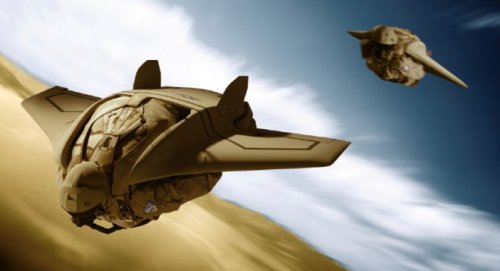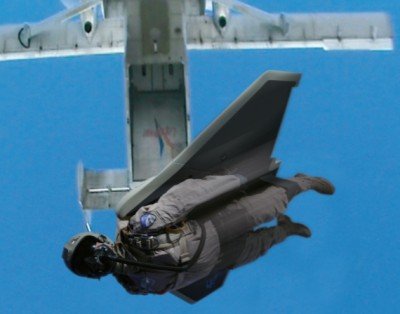Special Parachute and Logistics Consortium (SPELCO), a German venture between two companies, produces a variety of parachute systems, helmets, oxygen supplies, and other gear and services. One of their most interesting products is the Gryphon attack wing, a modular upgrade for parachute systems for use in “high-altitude, high-opening” (HAHO) jump missions, typically carried out by Special Forces. The 6-foot wing gives a glide ratio of 5:1, which means that a drop from 30,000 feet will allow the jumper to glide about 30 miles. SPELCO estimates that this would take around 15 minutes, giving an average speed of about 60 miles an hour.
“All equipment is hidden in a lifting body optimized for stealth, the radar-signature is extremely low,” says the Gryphon data sheet (PDF). “Detection of incoming Gryphon soldiers by airborne or ground radar will be extremely difficult.”
Gryphon has a guidance system and heads-up display navigation. With the addition of small turbojets used in UAVs, range is increased to more than 60 miles.
Source: "Look Out Below! Wingsuits Pushed for Airborne Assaults" by David Hambling on the Danger Room blog
http://www.wired.com/dangerroom/2009/12/look-out-below-wingsuits-pushed-for-airbone-assaults/
Gryphon data sheet: http://www.spelco.eu/library/media/solutions/Gryphon.pdf
http://www.youtube.com/watch?v=LNw57sPl57s
“All equipment is hidden in a lifting body optimized for stealth, the radar-signature is extremely low,” says the Gryphon data sheet (PDF). “Detection of incoming Gryphon soldiers by airborne or ground radar will be extremely difficult.”
Gryphon has a guidance system and heads-up display navigation. With the addition of small turbojets used in UAVs, range is increased to more than 60 miles.
Source: "Look Out Below! Wingsuits Pushed for Airborne Assaults" by David Hambling on the Danger Room blog
http://www.wired.com/dangerroom/2009/12/look-out-below-wingsuits-pushed-for-airbone-assaults/
Gryphon data sheet: http://www.spelco.eu/library/media/solutions/Gryphon.pdf
http://www.youtube.com/watch?v=LNw57sPl57s


